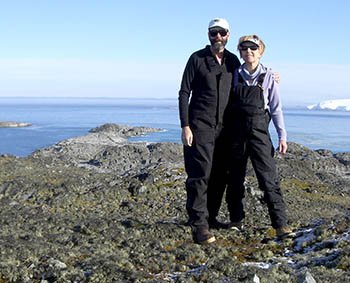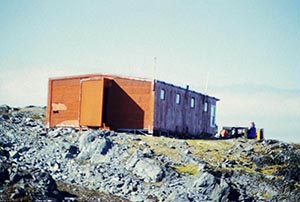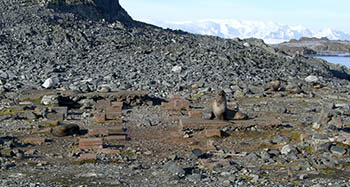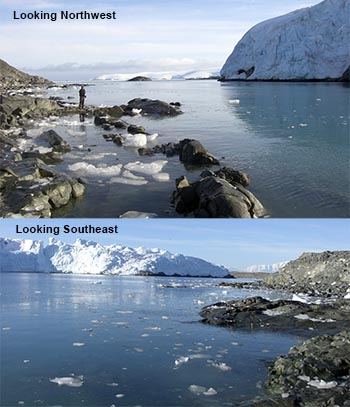
As I said in my last post, Sunday mornings are normally our "day off." We awoke to an unexpectedly calm and sunny day. Although like most of the scientists, our group is out in the field sampling many days, the station staff really only has Sundays (they get the whole day off) to enjoy the surroundings. So for them in particular, having a nice Sunday is a special treat.
Although I relish Sunday mornings as my one day to sleep in, today I only managed until about 7:00. Maggie and I both enjoyed the first part of the morning, her working on the NY Times crossword with friends and me checking the NCAA basketball highlights from last night. Maggie then worked up a water chemistry sample we do every morning (the ocean doesn't know it is our morning off).
I had told the boating coordinator that we wouldn't be using our boat to go diving until this afternoon, but about 9:30 Maggie and I realized that there were a lot of folks, particularly new folks who just arrived to staff the station for the winter, who had not gotten off station for recreation. Being altruists 8^) we decided that we really should take our dive boat out for a short recreational trip. Just for the others of course... Even though it was a beautiful morning we'd have preferred to be here working of course... (I'm lying through my teeth about that, of course...)

Although we needed to be back by noon so as to have time for lunch and then to be ready for the group meeting at 1:00 that kicks off our Sunday afternoon work time, we put a note on the whiteboard in the dining room that we had eight places on our dive boat for a quick trip to Old Palmer. The spots on the boat filled up almost immediately, and by a little after 10:00 we were on our way.
Old Palmer ("Old P" for short) is a special place for Maggie and me for multiple reasons. It is called Old Palmer because it is the site of the original Palmer Station. That was built in 1965. The current station just celebrated its 45th birthday this past week, having been dedicated on 17 March 1968. Old P was built on an ice free peninsula of Anvers Island called Norsel Point. New Palmer is on another ice free peninsula of Anvers Island called Gamage Point.
Maggie wrote a post earlier in the season about the buildings at the current Palmer Station. The photo to the left is one she took many years ago of the original, "old" Palmer Station. In her and my early years here, it was maintained as an emergency refuge should something catastrophic happen to make the current station uninhabitable. Fortunately, that was never needed. The US Antarctic Program tries to have as small a "footprint" in Antarctica as possible, and for that reason eventually it was decided that Old P should be removed.

All that remains now of Old P are the concrete footings. You can see those in the photo to the right that I took this morning. You can also see a couple of the current inhabitants. It is perfect habitat for fur seals, and there lots of them there. The one sitting up in the photo is perched on one of the concrete footings.
One reason that Old P was originally seen as a possible refuge in an emergency situation is that it was possible to go over the glacier behind the two stations (formally called the Marr Ice Piedmont) all the way from new Palmer to Old P. Back in the day, there were even occasional special cross country ski expeditions that did go all the way between the stations.
One part of the reason for abandoning the idea of having Old P as a refuge was that the glacier became too heavily crevassed (cracked) to make the trip safe. Over recent years the glacier has retreated from the ocean at an accelerating rate, almost certainly due in part to climate change. As it retreated, people started to realize that Old Palmer might not be on Anvers Island at all. The connection on the glacier between Anvers Island and Old Palmer/Norsel Point was getting thinner and thinner. Eventually in 2005 the last remnant of the glacier there fell into the sea and revealed that Old Palmer and Norsel Point were not really on Anvers Island after all.

The photo of Maggie and me at the top of the post was one we took a few years ago at the highest point of the "new" island that is the home to Old P (and always has been, although no one knew it for many years). Old Palmer would be below and behind the photographer. In the distance behind us at the tip of the island is Norsel Point. It is a very common dive site for our group in may seasons. Part of the experiment that Kate talked about on her last post has been deployed there since last year.
On our morning excursion, most of the rest of the folks who we went over to Old P with headed up to the high point where the photo of Maggie and me was taken. Maggie and I chose instead to go over to "the cut," which is what folks call the waterway that opened up in 2005 revealing that Old P and current Palmer are on separate islands.
In the image to the left I have combined two photos from this morning showing the cut. I was standing at its shore and have images looking both ways. In the one looking to the northwest you can see Maggie. In the lower one (taken from the same exact spot, just with me turned around), Palmer would be visible, about half a mile away, just to the left of the end of the cut if the view of it were not blocked by the glacier.
After our short hike we loaded ourselves back into our boat and headed home to the current station. Old P is a fun place to visit, but I'm glad that we have all the comforts and, particularly, the scientific resources provided by the current station. The fur seals sure do have a cool home though.
Have questions? We'll be happy to answer messages to